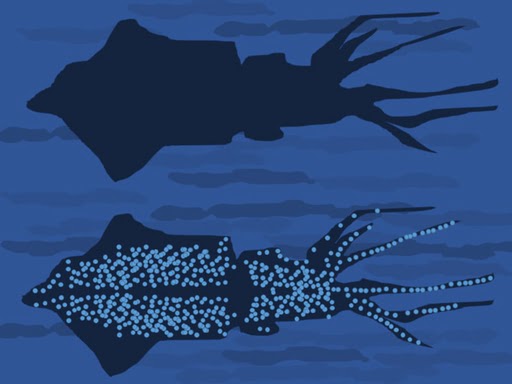Hawaiian bobtail squid possess a special bacteria known as Vibrio fischeri in specific organs in their body. This bacteria emits light, which helps conceal the squid’s shape as it moves through the ocean.
The majority of our planet is covered by the ocean and is home to a multitude of fascinating creatures. These creatures, both plants and animals, exhibit a wide range of diversity, each with its own unique adaptations and specialties that enable it to survive. Some creatures choose to engage in symbiotic relationships, but what does that really mean? Essentially, symbiosis refers to a mutually beneficial arrangement in which one organism helps another, and in return, receives assistance itself.
Symbiosis can take on various forms, some of which are quite simple. For instance, the Bluestreak cleaner wrasse swims directly into the mouths of sharks to clean their teeth. In this way, the shark gets a clean mouth free of parasites, and the wrasse gets a full stomach.
However, some forms of symbiosis are more complex, such as the relationship between the Hawaiian bobtail squid and a unique bacteria called Vibrio fischeri.
 Observe as this fearless Bluestreak cleaner wrasse enters the mouth of a moray eel (Photo Credit: -slowmotiongli/Shutterstock)
Observe as this fearless Bluestreak cleaner wrasse enters the mouth of a moray eel (Photo Credit: -slowmotiongli/Shutterstock)
The Organisms Involved
Hawaiian Bobtail Squid
Squids belong to the Cephalopoda class, which includes octopuses, cuttlefish, and squids. Squids themselves exhibit great diversity and can vary significantly in appearance. They can reach lengths of up to 13 meters (check out this video of a giant squid), but the specific squid discussed in this article is much smaller.
The Hawaiian bobtail squid measures only about 3 centimeters (1.2 inches) in length and weighs as little as 2.67 grams when fully grown. This small size makes them highly vulnerable to predators. To survive amidst larger fish in the sea, they require some form of protection, which is where our bacteria comes into play.
 The Hawaiian bobtail squid is a tiny creature that exhibits an interesting relationship with a bacteria known as Vibrio fischeri (Photo Credit: -slowmotiongli/Shutterstock)
The Hawaiian bobtail squid is a tiny creature that exhibits an interesting relationship with a bacteria known as Vibrio fischeri (Photo Credit: -slowmotiongli/Shutterstock)
The Bacteria
The bacterial species found in the Hawaiian bobtail squid is called Vibrio fischeri.
V. fischeri possesses the ability to emit light. Bioluminescence is the process by which a living organism produces its own light (similar to this fascinating mushroom or fireflies). This bacterial glow serves as a unique form of protection for the Hawaiian bobtail squid against predators.
Utilizing Light for Camouflage
It may seem counterintuitive for a squid trying to hide to emit lights, almost like a giant “Come eat me” sign. However, these squids employ a clever technique known as counter-illumination.
Imagine this squid swimming in the coastal waters of Hawaii. As the light penetrates the water, you can see a clear outline of a tiny squid swimming above you. Because the squid blocks the light, its silhouette is easily noticeable. However, if the squid were to produce its own light, it would disrupt the silhouette, making it less conspicuous against the light filtering through from the ocean’s surface.

An illustration of how counter-illumination would appear and how it aids in concealing its user (Photo Credit : Ian Alexander/Wikimedia Commons)
Nevertheless, this solely addresses how the squid utilize the bacteria, not how the bacteria gains entry initially.
How Do The Squids Acquire The Bacteria?
The squids are not naturally equipped with this bacteria in their systems. A group of squid eggs will all hatch simultaneously, and after they are born, they must obtain V. fischeri from the surrounding water. The only issue is that V. fischeri comprises less than 0.1% of the bacteria in the surrounding waters.
Thankfully, the squids have developed a special mechanism to counter this problem.
The squids possess a specialized organ that houses the bacteria. The ducts of these organs, through which the bacteria enter, are lined with a distinctive mucus.
This mucus prevents any bacteria other than V. fischeri from entering the specialized organs. Once V. fischeri enters the organs, it loses its ability to move around, living and reproducing within the squid. In return, the squid provides nourishment to the bacteria.
Now, the bacteria will spend the rest of its life being cared for by the Hawaiian bobtail squid, and the bacteria will help keep the squid less visible to predators.
Conclusion
Symbiosis can be observed throughout nature in various forms, even in ways similar to this one.
There are specialized bacteria in our own stomachs, for instance. They assist in breaking down complex sugars into simpler forms for absorption while deriving nutrition from the different substances we consume. There are even specialized bacteria in the roots of certain plants that aid in adding nitrogen (an essential element for plant survival) to the soil.
Symbiosis benefits both organisms; the Hawaiian bobtail squid and V. fischeri are considered model organisms for helping humans comprehend how these relationships function in nature. There is still much to be learned about the symbiosis between these two creatures, and uncovering further truths about them will hopefully provide us with an even greater understanding of the diverse array of animal relationships in nature.
